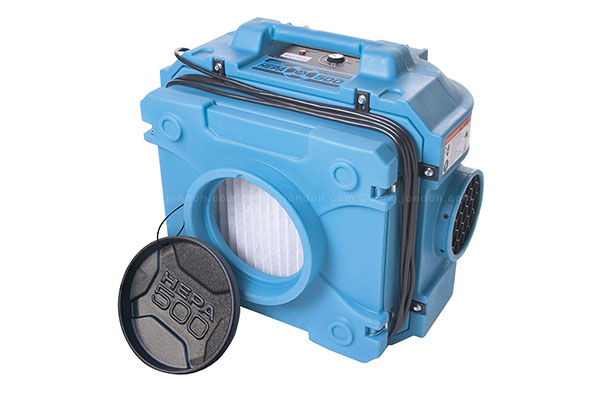The quality of indoor air is becoming more and more important to homeowners, especially as the Covid-19 pandemic has arrived in our country. However, for the water damage restoration professionals, maintaining the quality of pollutants in a home has always been a major concern. This is why air scrubbers, or negative air machines, are so important to the water damage industry. During any water damage cleanup, because drying experts use high velocity airflow to dry structural materials, an air scrubber becomes a necessary piece of equipment.
What Air Scrubbers Do
An air scrubber is a portable air filtration system that will remove particles, gasses, and/or chemicals from the air within a given environment. Air is drawn in through these machines and passed through a series of filters in an attempt to remove any airborne pollutants. After passing through the scrubber, the air is then returned to the environment. The size of the area needing air scrubbing will determine the size or number of air scrubbers required.
The most common usage of air scrubbers is when mold is being remediated. During the process of removal, it is extremely easy for mold spores to become disturbed and become airborne. When that happens there exists the possibility of the spores being inhaled by residents or workers and that they may be allowed to spread to previously unaffected areas. Using air scrubbers to process and filter out these airborne spores becomes necessary.
Air scrubbers usually contain 2-3 filters, offering different stages of filtration:
Pre-Filters – these are the first filters the incoming airflow contacts. There may be one or two of these in the scrubber, designed to capture different sizes of particles for each stage. Depending on the amount or type of particles in the air, these pre-filters should be changed daily or at the start of each job. When changing any pre-filter, it should be done on-site with the scrubber running. The used filters should be bagged and sealed before removing them from the work area to prevent accidental cross contamination with previously unaffected areas.
Carbon Filters – these filters are generally used in place of one of the pre-filters and are designed to absorb organic vapors, reducing odors. These filters are often used in sewage and fire restoration projects, but may be used anytime odor is a concern.
Primary Filter – these are often HEPA (high efficiency particulate air) rated. They capture 99.97% of particles down to 0.3 microns in size. They are the real workhorse of the air scrubber.
Why An Air Scrubber Is Needed
No matter how clean the area that is damaged by water is before the loss happens, it will be contaminated once the water has affected it. This could be a result of the type of water that caused the loss (category 1, 2 or 3 water) or do to the water mixing with any contaminants already present in the affected area. Now a restoration company comes in and sets up several high-velocity air movers to assist in drying the area. That airflow will move any contaminants left behind after the water is removed into the air that you and your family breathe.
Almost every air scrubber will be a HEPA (high-efficiency particulate air) rated machine, filtering 99.97% of particles in the air that are 0.3 microns or larger. To give you an idea about how small 0.3 microns is a human hair is 40-300 microns in size. The average mold spore is between 10-30 microns in size.
When an air scrubber is used during mold remediation, it is used to capture any mold spores that are disturbed during the removal and float up into the air where people could inhale them. The scrubber and the containment chamber stops any possible spread of mold spores to previously unaffected areas.
Air Scrubber vs. Negative Air Machine
These two terms are generally interchangeable; the real difference is in how the machine is used. Inside containment chambers (usually a mold remediation is performed under containment) the chamber is kept under negative air pressure to prevent any contaminant from escaping from the chamber. An air scrubber is used but instead of exhausting the processed air inside the chamber, it is exhausted outside the chamber. This creates a negative pressure inside the chamber. As any contaminant particle approaches the seal of the chamber, air trying to enter the chamber to equalize the two pressures (inside and outside) pushes the contaminant particle back into the chamber where the air scrubber can capture it.
Should Air Scrubber Use Be Covered By Insurance?
Insurance adjusters who do not authorize the use of HEPA-filtered air scrubber on every water loss should rethink their position. A water loss poses a significant opportunity for particles of contamination to proliferate.
The very activity undertaken to remediate the loss can increase the risk of indoor air contamination. As high-velocity airflow evaporates water from surfaces, contaminants such as mold spores and dust particles are likely to become airborne. Workers and residents exposed to these pollutants can inhale them. These airborne particles can also create housekeeping and cleanup issues that can increase the cost of the insurance claim.
According to the IICRC (Institute of Cleaning and Restoration Certification) S500 Water Loss Restoration Standard, the standard reference guide for water damage technicians worldwide, one or more air scrubbers should be used on every water remediation project. These units increase the safety of the workers and the residents.
Setting Up and Operating an Air Scrubber
The are several different methods of utilizing air scrubbers during restoration and remediation projects. Whenever there are high levels of contaminants like dust, smoke, mold, or other particulates, an air filtration device (AFD) should be used.
The most critical factor when determining air scrubber operation is air changes per hour. This is how many times every cubic foot of air in an area should be processed through the AFD during each hour of operation. The minimum number of air changes per hour is 4 and they can be as high as 12. To arrive at the number of air scrubbers needed, multiply the cubic feet of the area by the number of changes and then divide by 60 (AFD’s are rated by their CFM, or cubic feet per minute, of air output), dividing by 60 converts the answer from hours to minutes. You can then divide the required amount of CFM’s by the air scrubber’s CFM output to determine if you need one or more air scrubbers. Always round up, if you need 1.5 air scrubbers, use two.
When using an air scrubber inside a containment chamber, you should exhaust the processed air outside the chamber to create negative air pressure. Always check the level of negative air pressure using a manometer. If the negative pressure is too great, many scrubbers have variable speed controls. Their speed of operation can be dialed up or down accordingly. If the scrubber can’t be adjusted to the correct negative pressure level, you can always tape a pre-filter to the chamber’s poly wall and cut the poly away on the outside of the chamber. This will allow filtered air to either enter or exit the chamber to help achieve an acceptable negative pressure.
When the work has been completed, the air scrubber should be the last piece of equipment to be turned off. Before shutting down the air scrubber, it should be sealed to keep any captured contaminants inside it while removing it from the building.
In Conclusion
You may say this, “Before the water loss my carpets had recently been professionally cleaned and the source of the loss was clean water from a broken water pipe. We don’t have any pets and everyone removes their shoes before entering the house. Do I really still need an air scrubber on my loss or is the restoration company just trying to run up my bill?”
We say try this little experiment. Pour just one small glass of clean tap water on your “clean” carpet. Use a clean cloth to soak up the water. Wring the water out of the cloth and back into the glass. Look at it very closely. It has to still be clean, doesn’t it? Clean carpet, clean water, and a clean cloth were used. Do you really want to drink that “still clean” water? That’s why, in our opinion, an air scrubber should be used on every water loss, clean water or not.








